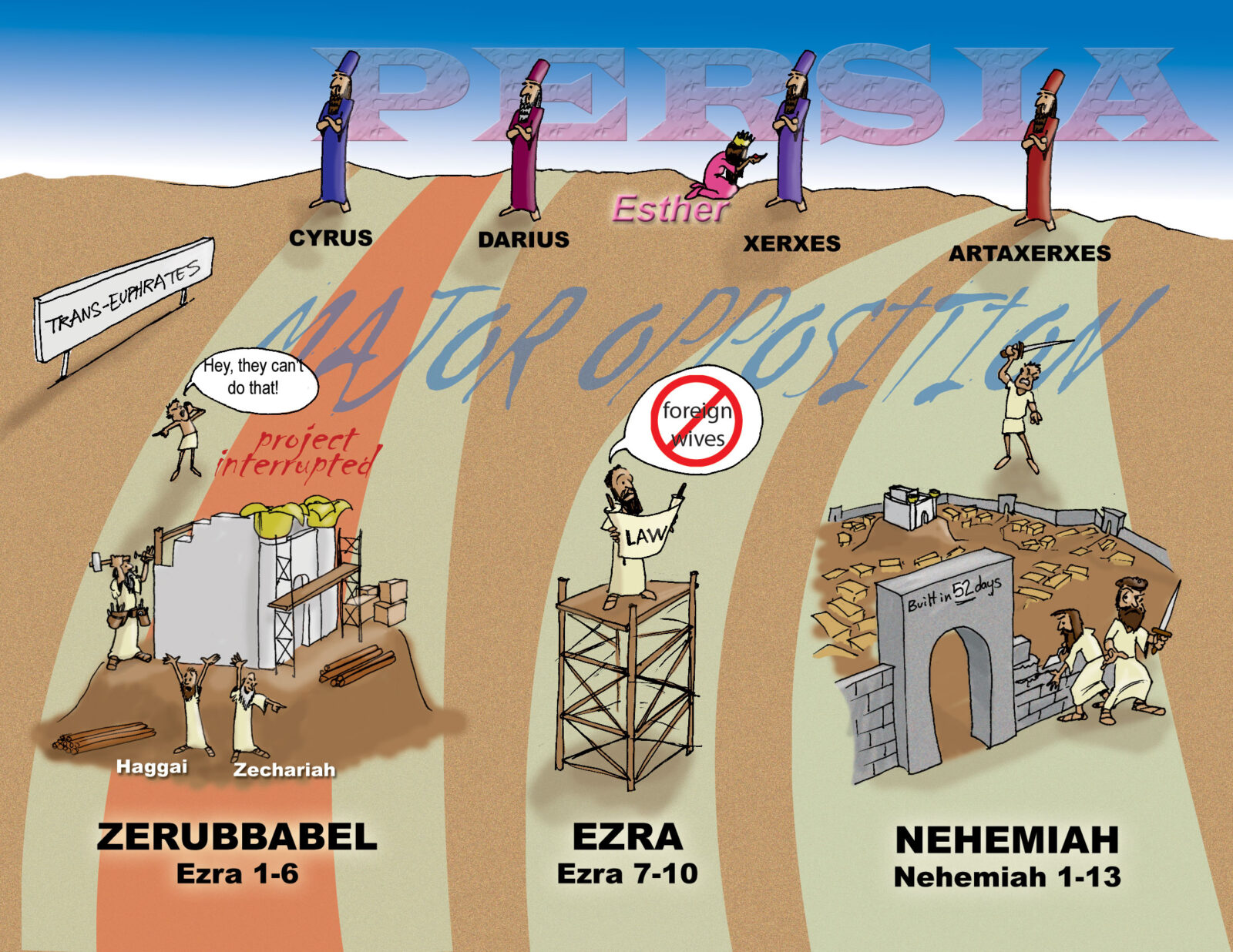To accompany your Come Follow Me study for July 18-24
In addition to reading these prescribed chapters, you may enjoy:
- The corresponding material from the Institute student manual found in the online Gospel Library
- The video Come Follow Me 2022 LDS (July 18-24) Ezra 1, 3-7 & Nehemiah 1, 4-6, 8 | Return & Rebuild at https://www.youtube.com/watch?v=5gkKa9lDXZQ
- The video Overview: Ezra and Nehemiah at https://www.youtube.com/watch?v=MkETkRv9tG8
If you would enjoy seeing a Kahoot game related to this material which you could use for your own amusement or with your family or class, click here: https://create.kahoot.it/share/ezra-1-3-7-nehemiah-2-4-6-8/4888dd6e-9342-4b64-908b-52b91c7cb990. (To use it with a group, after clicking on this link, you will need to log into Kahoot, creating a free account if you have not done so previously, then click on the blue “Start” button.)
Points to Ponder in Ezra 1; 3-7; Nehemiah 2; 4-6; 8
1. What do we learn from these chapters about how the Lord can work with non-members to accomplish His purposes?

2. Why, then, would not Zerubbabel accept help offered by the Samaritans to rebuild the temple?
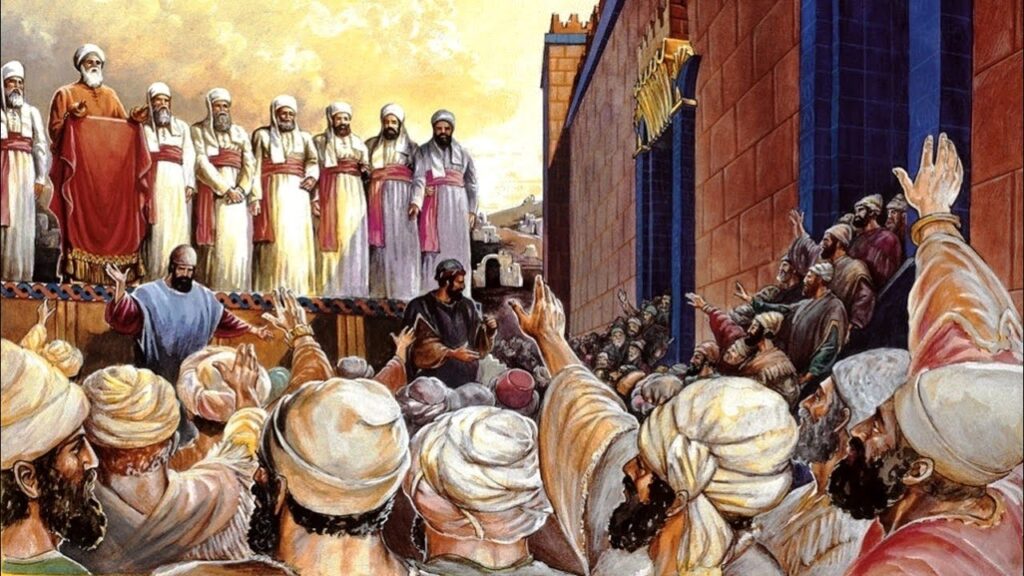
3. To what extent do you believe we should cooperate with non-Latter-day Saints today, and to what extent should we remain apart?
4. Why did the Jews first rebuild the altar when there wasn’t even a temple yet to enclose it? What modern parallel are you aware of?
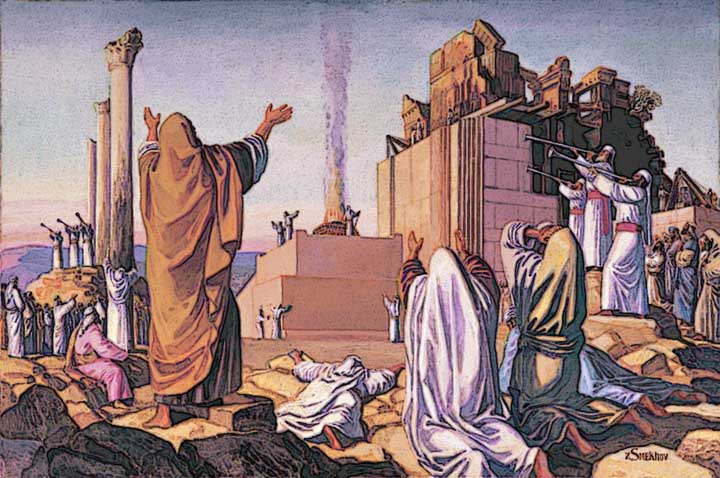
5. Why did Artaxerxes (Ezra 4:19-21) and Darius (Ezra 6:1-7) both alter their decisions concerning the Jews, but in opposite directions, after searching the royal archives? What “moral” do you draw from these accounts?
6. What was particularly ironic about Darius’ reply to Shethar-bozenai? (5:6 to 6:6-8.)
7. In Ezra 8, which was not specifically assigned for this week’s reading, we find that Ezra proclaimed a fast before he and his companions left Persia for their old homeland in Judah. What do we learn from both Ezra 8:21-22 as well as from Ezra 7:9 that help us understand why he felt the need to fast?
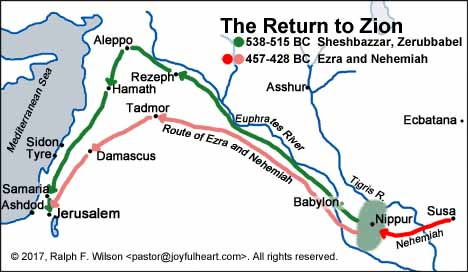
8. What parallels can you see between Nehemiah and Moses? Or between Nehemiah and each of us?
9. Why did it take as long as it did to rebuild Jerusalem and its temple? What can we learn from it as we work today to build a latter-day Zion?

10. What qualities of leadership do you see in Nehemiah?

11. What elements can you find in Nehemiah 8 of a good Gospel Doctrine class (or seminary or institute class)?
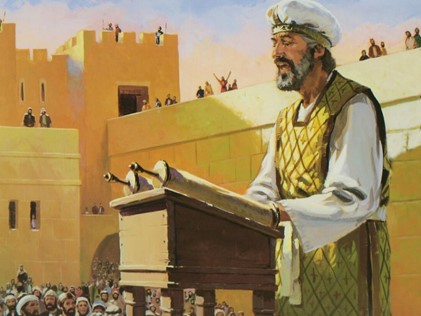
Possible Answers to Points to Ponder in Ezra 1; 3-7; Nehemiah 2; 4-6; 8
1. What do we learn from these chapters about how the Lord can work with non-members to accomplish His purposes?
We find Cyrus, not part of the covenant people, mentioned by name by Isaiah decades before his birth and inspired by God to initiate the rebuilding of the temple in Jerusalem. (Isaiah 44:28; 45:1; Ezra 1:1-2). Similarly, the Lord doubtlessly inspires good men and women of all nations and creeds to help advance His work in our time.
2. Why, then, would not Zerubbabel accept help offered by the Samaritans to rebuild the temple?
Possible reasons appear to include:
- Though the Samaritans professed to want to worship the same God, they practiced an apostate religion. According to 2 Kings 17:34, “They fear not the Lord, neither do they after their statutes, or after their ordinances, or after the law and commandment which the Lord commanded the children of Jacob, whom he named Israel.” No doubt if they had helped with the building of the temple, they would have wanted some voice in what was done there, how, and by whom. And the Jews may have feared that by aligning themselves with the Samaritans, they would disqualify themselves for the divine favor they hoped to maintain.
- The Samaritans’ offer to help was just a ruse, an attempt to get the opportunity to sabotage the work rather than help it along.
3. To what extent do you believe we should cooperate with non-Latter-day Saints today, and to what extent should we remain apart?
It makes all the sense in the world to cooperate with other good-hearted people and organizations in helping the poor, working for peace, and upholding good moral principles. Obviously, we would never compromise on doctrine, which is established by God Himself, through revelation, nor compromise on moral principles.
4. Why did the Jews first rebuild the altar when there wasn’t even a temple yet to enclose it? What modern parallel are you aware of?
Even before the rest of the temple was completed, the people would be able to offer sacrifices again in the prescribed manner. In our day, the baptismal font was completed and used in the Nauvoo Temple before the rest of the temple was completed.
5. Why did Artaxerxes (Ezra 4:19-21) and Darius (Ezra 6:1-7) both alter their decisions concerning the Jews, but in opposite directions, after searching the royal archives? What “moral” do you draw from these accounts?
Artaxerxes found only records which seemed to substantiate the claim that through the years the Jews had been troublemakers, so he issued a proclamation that rebuilding in Jerusalem be stopped. Darius found Cyrus’ original decree that the Jews were to be aided in their return and reconstruction. We might conclude from this that we need to take “research” and “history” with a grain of salt, as very often substantiation can be found for almost any position one might wish to take. Good records, of course, are vital, but we must be careful to find the whole truth and not just a few cherry-picked facts that support our preconceived position on a given issue
6. What was particularly ironic about Darius’ reply to Shethar-bozenai? (5:6 to 6:6-8.)
Shethar-bozenai and his associates wanted to convince Darius to make the Jews stop their work of rebuilding the temple. After researching and pondering the matter, Darius not only reaffirmed that Jews had permission to build, but that they were to be financed! It’s a bit like Haman, who ended up getting hanged on the gallows he had built for Mordecai, as we’ll see when we get to the Book of Esther.
7. In Ezra 8, which was not specifically assigned for this week’s reading, we find that Ezra proclaimed a fast before he and his companions left Persia for their old homeland in Judah. What do we learn from both Ezra 8:21-22 as well as from Ezra 7:9 that help us understand why he felt the need to fast?
This was a four month journey, over about 700 miles, with “enemies” along the way. This was to Zerubbabel, Ezra, and Nehemiah what the journey from Nauvoo to the Salt Lake valley was for Brigham Young and his followers.
8. What parallels can you see between Nehemiah and Moses? Or between Nehemiah and each of us?
Both Moses and Nehemiah willingly left the comforts of a palace to side with an unpopular minority and lead an exodus across hundreds of miles. But each of us also once lived in a heavenly “palace” and voluntarily opted to leave it to experience the struggles and blessings of mortality. Just as Nehemiah worked to rebuild Jerusalem and Moses worked to produce a “Zion” people, so do we have the opportunity and responsibility to work toward the building of a latter-day Zion, a holy city, to prepare for the return of the Savior.
9. Why did it take as long as it did to rebuild Jerusalem and its temple? What can we learn from it as we work today to build a latter-day Zion?
The delays in Ezra’s and Nehemiah’s day seem to have stemmed from:
- Disobedience and unworthiness of so many of the Jews
- Opposition from the Samaritans
- Governmental opposition (at times)
No doubt many expected that the New Jerusalem in our day would have been built much sooner than has turned out to be the case. The Lord told the Saints in 1833 that we have something to do with the timetable. He said: “There is even now already in store sufficient, yea, even an abundance, to redeem Zion, and establish her waste places, no more to be thrown down, were the churches, who call themselves after my name, willing to hearken to my voice.” (D&C 101:75.) He further said, “After much tribulation … cometh the blessing.” And in D&C 105:9, He revealed that “it is expedient in me that mine elders should wait for a little season for the redemption of Zion, that they themselves may be prepared, and that my people may be taught more perfectly, and have experience, and know more perfectly concerning their duty, and the things which I require at their hands.”
But we can rest assured that just as the prophesied return of the Jews from Babylon and the rebuilding of the temple in ancient times finally occurred, just as the Lord had promised, so will the latter-day Zion be built, in the Lord’s due time, and we will be perfectly satisfied that all His prophecies and promises were fulfilled to the letter.
10. What qualities of leadership do you see in Nehemiah?
- He was without guile, shown by the fact he couldn’t hide his sadness from the king. (2:1-3)
- He was self-sacrificing, leaving a good job in Persia to help his people in Judea.
- He took no salary and levied no taxes (Nehemiah 5:14-15), much like King Benjamin in the Book of Mormon.
- He was a good organizer, managing to rebuild the walls of the city in only 52 days, despite local opposition (6:15)
- He inspired the people with “a mind to work” and successfully encouraged them to not fear their enemies but to trust in the Lord and to fight for their families and homes, reminiscent of Captain Moroni’s appeal to the Nephites in Alma 46:12. (Nehemiah 4:6, 14)
- He was religious and sensitive to the Spirit (7:5)
- He was unwilling to enter the temple to save his life (6:10-14), either because he respected the sanctity of the temple or because he saw through the plot of Shemaiah
- He demonstrated both faith and works, trusting in God but posting guards and having the people working with one hand while holding a weapon in the other. (4:8-9, 17, 23). This is reminiscent of the situation during the building of the Kirtland Temple, where mobs threatened to tear down the walls of the temple and armed guards had to be posted to protect the work. According to Heber C. Kimball, for weeks some men didn’t remove their working clothes and slept with their rifles in their arms.
- He gave specific assignments to different families, including even their daughters! (3:12)
- He was concerned for the poor and was impatient with those who charged usury! (chap. 5)
- He prioritized well, as exemplified by his sending a message to Sanballat and Geshem that “I am doing a great work, so that I cannot come down: why should the work cease, whilst I leave it, and come own to you?” (6:3)
11. What elements can you find in Nehemiah 8 of a good Gospel Doctrine class (or seminary or institute class)?
- There was a large attendance of people who really wanted to be there and were excited to learn. (8:1
- Everyone was attentive. (8:3)
- Ezra focused on using the scriptures. (8:3)
- The people were there to worship as well as learn (8:6)
- There was evidently small group instruction, with various discussion leaders (8:7)
- The teachers read distinctly, explained the content, and made sure the people understood. (8:8)
- The people celebrated afterwards, eating and drinking and making “great mirth.” (8:12)
- The people applied what they had learned, celebrating the feast of tabernacles. (8:16-17)
